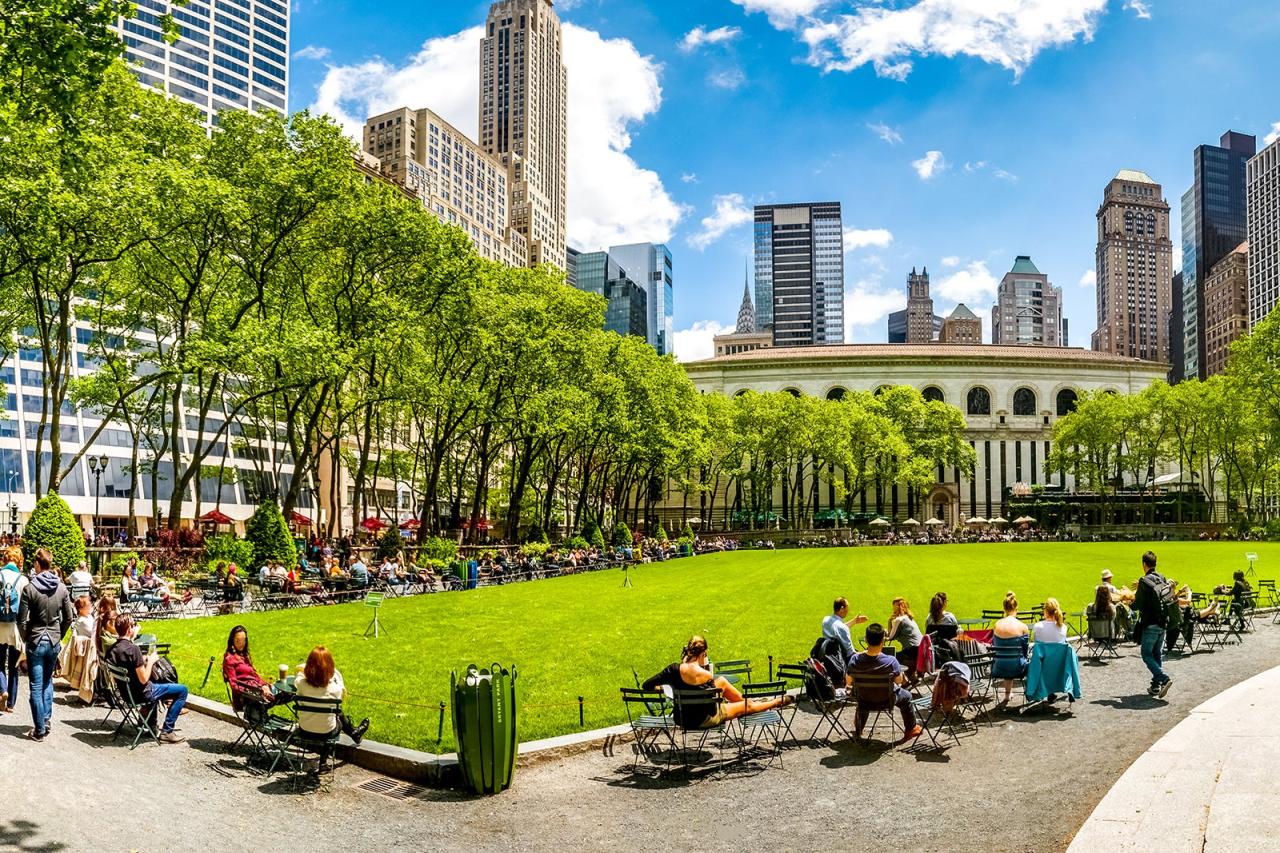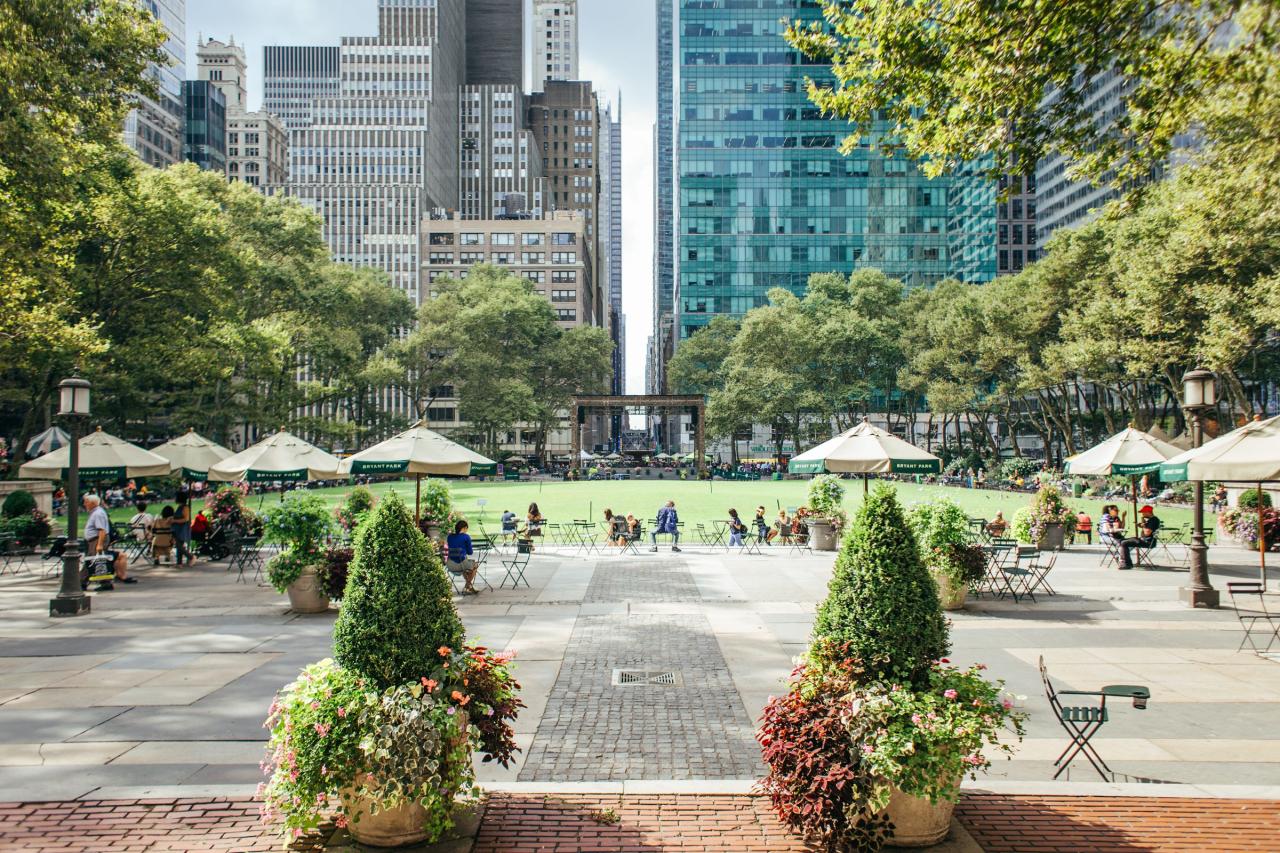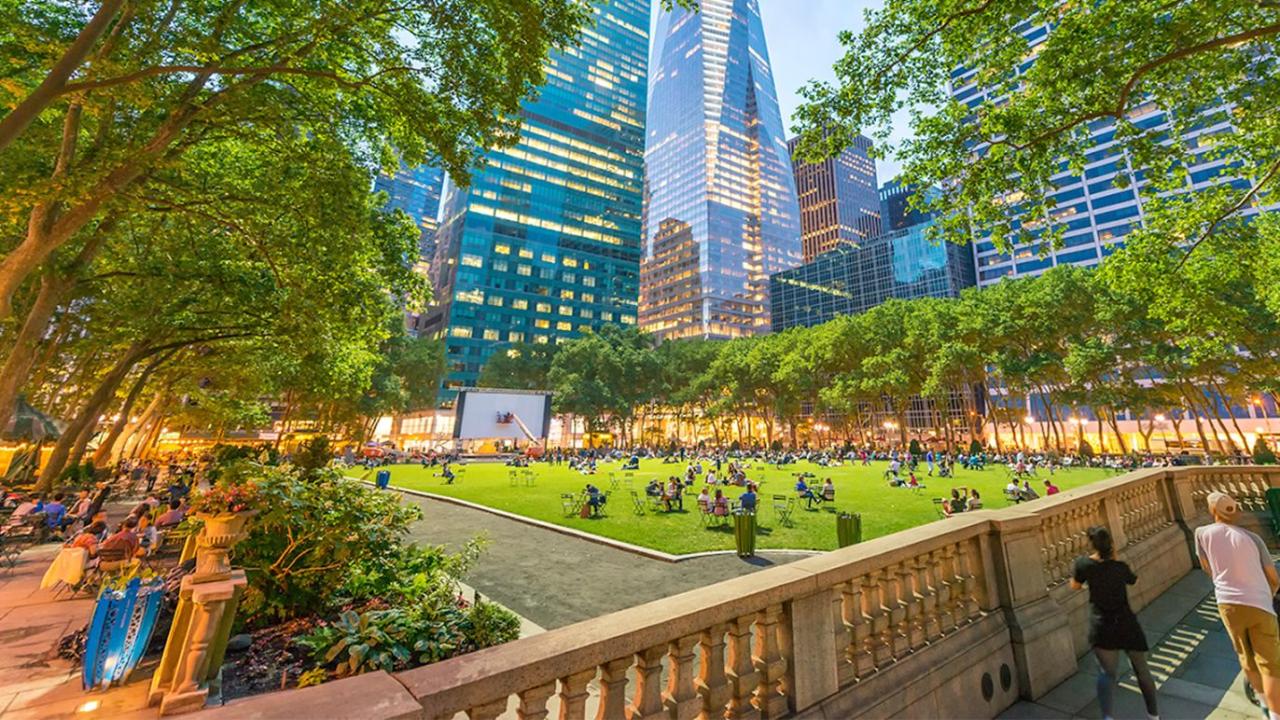Bryant Park, a verdant oasis nestled in the bustling heart of Midtown Manhattan, is a testament to the power of urban planning and community engagement. Its storied history, captivating design, and vibrant cultural programming have transformed it into a beloved destination for locals and visitors alike.
From its humble beginnings as a potter’s field to its present-day status as a thriving cultural hub, Bryant Park has witnessed countless events and played a pivotal role in shaping the fabric of New York City.
Bryant Park History
Bryant Park, a verdant oasis nestled amidst the bustling metropolis of New York City, has a rich and storied past that spans over a century.
The park’s origins can be traced back to 1686, when it was part of the common lands granted to the city by King William III. In the early 19th century, the area was known as the Potter’s Field, a potter’s workshop and burial ground for the city’s poor.
Establishment and Development
In 1823, the city acquired the land and transformed it into a public park, initially named Reservoir Square after the Croton Distributing Reservoir that was constructed beneath it. In 1853, the park was renamed Bryant Park in honor of the renowned American poet and editor, William Cullen Bryant, who lived nearby and was a strong advocate for its preservation.
Over the years, Bryant Park has undergone several renovations and expansions. In the late 19th century, it was redesigned by Frederick Law Olmsted and Calvert Vaux, the landscape architects responsible for Central Park. In the 1930s, the park was enlarged and its iconic Art Deco pavilions were constructed.
In the 1970s, Bryant Park fell into disrepair and became a haven for crime and drug use. However, in the 1980s, a group of concerned citizens, led by the Bryant Park Restoration Corporation, launched a successful campaign to restore the park to its former glory.
Notable Individuals and Organizations
Numerous individuals and organizations have played significant roles in the development and preservation of Bryant Park. Among them are:
- William Cullen Bryant:American poet, editor, and advocate for the park’s preservation.
- Frederick Law Olmsted and Calvert Vaux:Landscape architects who redesigned the park in the late 19th century.
- The Bryant Park Restoration Corporation:A non-profit organization that led the effort to restore the park in the 1980s.
Park Design and Features
Bryant Park is a public park located in the heart of Midtown Manhattan, New York City. It was designed by Frederick Law Olmsted and Calvert Vaux, the same architects who designed Central Park. The park’s overall design is based on the principles of the Picturesque movement, which emphasized the creation of natural and picturesque landscapes in urban environments.
The park is divided into four sections: the Great Lawn, the Terrace, the Oval Lawn, and the Promenade. The Great Lawn is a large, open space that is used for a variety of activities, including sunbathing, picnicking, and concerts. The Terrace is a raised area that offers stunning views of the surrounding city.
The Oval Lawn is a smaller, more intimate space that is often used for weddings and other special events. The Promenade is a long, winding path that connects the different sections of the park.
Architectural Elements
The park’s architectural elements are designed to complement the natural beauty of the landscape. The most prominent architectural feature is the Bryant Park Pavilion, which is a glass-enclosed structure that houses a restaurant and a visitor’s center. Other architectural elements include the Josephine Shaw Lowell Memorial Fountain, the William Cullen Bryant Memorial, and the Reading Room.
Landscaping
The park’s landscaping is designed to create a variety of visual experiences. The Great Lawn is a vast expanse of green space, while the Terrace is a more formal space with manicured gardens. The Oval Lawn is a more intimate space with a variety of trees and shrubs.
The Promenade is lined with trees and offers stunning views of the surrounding city.
Public Art Installations
Bryant Park is home to a number of public art installations. The most famous is the Josephine Shaw Lowell Memorial Fountain, which is a bronze sculpture of a woman surrounded by children. Other public art installations include the William Cullen Bryant Memorial, which is a bronze statue of the poet, and the Reading Room, which is a glass-enclosed structure that houses a collection of books.
Amenities
Bryant Park offers a variety of amenities for visitors, including seating, restrooms, and food vendors. The park also has a number of free Wi-Fi hotspots. Bryant Park is a popular destination for both tourists and locals, and it is a great place to relax and enjoy the outdoors in the heart of New York City.
Cultural and Community Events
Bryant Park has established itself as a vibrant cultural hub in the heart of New York City, hosting a diverse array of events and programs that cater to the interests of the local community and visitors alike.
The park’s commitment to fostering cultural enrichment and community engagement is evident in its year-round calendar of events, which includes:
Concerts and Performances, Bryant park
- Bryant Park Summer Concert Series: A free concert series featuring renowned artists from various musical genres, from jazz to pop and classical.
- Bryant Park Movie Nights: Free outdoor screenings of classic and contemporary films, offering a cinematic experience under the stars.
- Shakespeare in the Park: A beloved tradition, the Public Theater’s free performances of Shakespeare’s plays bring the Bard’s words to life in a unique outdoor setting.
Festivals and Exhibitions
- Winter Village: A festive holiday market featuring local vendors, ice skating, and holiday-themed activities.
- Bryant Park Summer Film Festival: A celebration of independent and international cinema, showcasing a diverse range of films from around the world.
- Bryant Park Food Festival: A culinary extravaganza featuring food vendors from the city’s top restaurants and a showcase of diverse cuisines.
Community Engagement Initiatives
Bryant Park is dedicated to promoting inclusivity and community engagement through various initiatives, such as:
- Reading Room: A free public space offering a quiet retreat for reading and relaxation.
- Bryant Park Pop-Up Pool: A refreshing oasis during the summer months, providing free swimming and water activities.
- Community Yoga and Fitness Classes: Free fitness classes led by certified instructors, encouraging physical and mental well-being.
Economic Impact and Sustainability
Bryant Park serves as a catalyst for economic vitality in its surrounding neighborhood. The park attracts visitors and tourists, boosting foot traffic and supporting local businesses. The presence of the park has also contributed to increased property values in the area.
Bryant Park is committed to promoting sustainability and environmental conservation. The park has implemented several initiatives to reduce its environmental impact, including using renewable energy sources, installing energy-efficient lighting, and implementing a comprehensive recycling program. The park also hosts educational programs and events to promote environmental awareness and stewardship.
Partnerships and Collaborations
Bryant Park has established partnerships with various local businesses and organizations to enhance its economic and environmental impact. For example, the park has partnered with the Bryant Park Corporation, a non-profit organization that supports the park’s operations and maintenance. The park has also collaborated with local businesses to offer food and beverage options to visitors, creating employment opportunities and supporting the local economy.
Comparisons to Other Urban Parks
Bryant Park stands out among notable urban parks due to its innovative design, exceptional amenities, and robust cultural programming. Compared to Central Park, its larger counterpart in Manhattan, Bryant Park offers a more intimate and curated experience, with a focus on relaxation and community engagement.
Unlike Millennium Park in Chicago, which is renowned for its iconic sculptures and public art, Bryant Park emphasizes greenery and natural elements, creating a tranquil oasis in the heart of the city.
Unique Features and Innovative Approaches
Bryant Park’s unique features set it apart from other urban parks. The park’s iconic carousel, featuring 40 hand-painted horses, provides a nostalgic and playful experience for visitors of all ages. The Reading Room, a cozy and inviting space, offers a tranquil retreat for reading and contemplation.
Additionally, Bryant Park’s seasonal ice skating rink transforms the park into a winter wonderland, offering a unique and festive activity for New Yorkers and tourists alike.
Best Practices and Lessons Learned
Bryant Park has drawn inspiration from other successful park systems worldwide. The park’s emphasis on community engagement and programming mirrors the approach of the High Line in New York City, which has transformed an abandoned elevated railway into a vibrant public space.
Similarly, Bryant Park’s focus on sustainability and environmental stewardship aligns with the principles of London’s Hyde Park, which has implemented innovative measures to reduce its carbon footprint.By studying and adapting best practices from other urban parks, Bryant Park has established itself as a model for creating vibrant and sustainable public spaces that meet the diverse needs of urban communities.
Future Plans and Development: Bryant Park
Bryant Park is a dynamic and evolving space, with ongoing plans and developments to enhance its offerings and meet the changing needs of the community.
Renovations and Improvements
The park is currently undergoing a series of renovations and improvements, including upgrades to its infrastructure, amenities, and green spaces. These enhancements aim to improve accessibility, sustainability, and overall visitor experience. The renovations include:
- Renovation of the restrooms and water fountains
- Installation of new seating and lighting
- Expansion of the children’s play area
- Addition of new trees and landscaping
- Upgrade of the electrical and irrigation systems
Challenges and Opportunities
As Bryant Park continues to evolve, it faces both challenges and opportunities. One of the primary challenges is maintaining the park’s balance between public use and private development. The park is surrounded by commercial and residential buildings, and balancing the interests of these stakeholders is crucial to its success.Another challenge is ensuring that the park remains accessible and inclusive to all members of the community.
This includes addressing issues of equity and affordability, as well as providing programming and amenities that cater to diverse needs.However, Bryant Park also presents significant opportunities for the future. The park’s central location and proximity to major cultural institutions make it an ideal venue for events and activities that attract visitors from around the city and beyond.
Additionally, the park’s green spaces and open areas offer a much-needed respite from the urban environment, contributing to the well-being of the community.
Role in the Evolving Urban Landscape
Bryant Park plays a vital role in the evolving urban landscape of New York City. As the city continues to grow and change, the park provides a constant and adaptable space that meets the needs of its surrounding community. The park’s open spaces, cultural events, and community programming contribute to the vibrancy and livability of the city.
Closing Notes
As Bryant Park continues to evolve, it remains a beacon of innovation and inclusivity, adapting to the changing needs of its community while preserving its timeless charm. Its legacy as a vibrant urban oasis is sure to endure for generations to come, inspiring other cities to create vibrant public spaces that foster community and cultural enrichment.
FAQ Summary
What is the history of Bryant Park?
Bryant Park was established in 1847 as a potter’s field. In the early 20th century, it was transformed into a public park and named after the poet and journalist William Cullen Bryant.
What are some of the notable features of Bryant Park?
Bryant Park is known for its elegant design, which includes a central lawn, tree-lined walkways, and a reflecting pool. It also features a carousel, a skating rink, and a variety of public art installations.
What types of events are held in Bryant Park?
Bryant Park hosts a wide range of events throughout the year, including concerts, festivals, exhibitions, and film screenings. It is also a popular spot for yoga classes, dance performances, and other community gatherings.


